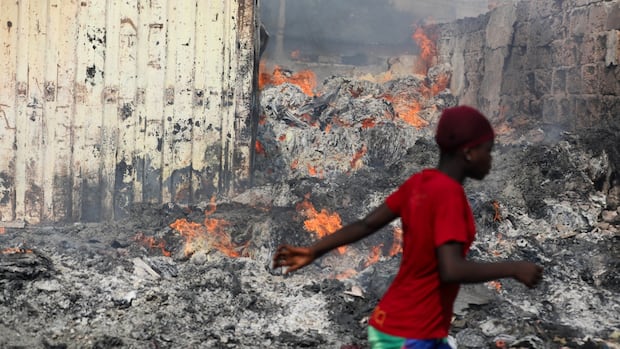As It Happens6:36Ghanaians call on fast fashion brands to step up after fire guts world’s largest used clothing market
Yayra Agbofah has barely slept since a fire ripped through the world’s largest second-hand clothing market to the ground just over a week ago.
The Jan. 2 blaze at the Kantamanto Market in Ghana’s capital city of Accra reduced huge swaths of the market to ashes, destroying millions of items of used clothing and jeopardizing the livelihoods of more than 30,000 people.
Agbofah runs The Revival, an organization that creates art and fashion using materials the market’s vendors can’t sell. His company’s storage facility was destroyed in the fire, but his studio was not affected.
Many of his friends and family, he says, were not so lucky.
“I have not been able to have proper sleep because of the state of emergency and having to see my people, family and friends break down in tears because their livelihoods have been destroyed and you have to start from scratch,” he told As It Happens host Nil Kӧksal.
Agbofah is raising money to help rebuild the market, which he says plays a pivotal role in Accra’s economy and helps keep millions of tonnes of clothes in circulation that would otherwise end up oceans and landfills.
He and others are also calling on fast fashion brands like Shein, H&M and Zara — none of which responded to CBC’s request for comment — to contribute financially to the market’s clean-up and reconstruction.
“We try to clean up their mess,” he said. “It’s the least they could do to take responsibility.”
The cause of the fire is still under investigation.
From Canadian donation bins, to Ghanaian oceans
Kantamanto Market’s vendors recirculate about 15 million pieces of used clothing every month through resale, reuse, repair and remanufacturing, according to the Or Foundation, an American-Ghanaian charity that works to find sustainable solutions to fast fashion waste.
The charity estimates the blaze reduced more than 8,000 stalls to dust and directly impacted 10,000 workers.
The items sold there mostly come from Canada, the U.S. and England, Agbofah said, arriving almost daily in massive shipping containers in Accra’s dockyards.
People in wealthy countries donate used clothing to charities and thrift stores, which take what they need and discard the rest. What remains is exported to lower-income countries.
But what vendors in those countries can’t sell gets thrown away, ending up in landfills or in the ocean, where it clogs beaches and destroys marine environments.
“Whatever actions you take in the U.S. and Canada has a ripple effect on us here. If you consume so much, we have to deal with so much because it ends up with us,” Agbofah said.
“I’m sure a lot of people think, donating to charity, I’m helping or I’m doing something, but it’s placing a burden on us.”

The Or Foundation says it is contributing $1 million U.S. to relief and reconstruction in the fire’s aftermath. But it is calling on clothing companies to contribute.
“For too long, the fashion industry has used places like Kantamanto as a destination for their excess, but not enough attention has been paid to Kantamanto’s work to process the output of the linear economy,” fashion designer Nutifafa Mensah, the charity’s peer education lead, said in an emailed statement.
“This is truly a circular model lost to ashes, and as Kantamanto Market seeks to rebuild itself in all its tenacity and resilience, we’re pleading for the fashion industry’s support in recovery.”
The Ghana Used Clothing Dealers Association (GUCDA), which represents used items importers in the country, has also called on charities, companies and the country’s government to help.
CBC has reached out to Ghana’s Ministry of Trade and Industry for comment.
Rebuilding already underway
Tens of thousands of Ghanaians depend on the market to make a living, Agbofah says. That’s why they are already in the process of rebuilding.
“People are working day and night to get the market back on its feet, and it’s an amazing thing to see,” he said.
“It’s restoring hope and also showing the resilience of the Kantamanto community, that no level of devastation or fire would take away the unity and love we have for the market.”
Agbofah says he fell in love with Kantamanto the first moment he laid eyes on it as a child.
“That is where I found things that I see in the media, things that I see in magazines that we didn’t have access to brand new,” he said.
He also saw economic opportunity. Not only does he create clothing out of textile waste, he also works as a stylist, mixing and matching what he calls “rare gems” that he sources from Kantamanto’s stalls.
Despite his affection for the market, he says it can’t possibly keep up with the glut of items arriving on Ghana’s shores, and it’s harder than ever to turn a profit.
“If you’re donating to charity, you should think: This product I’m donating, is it something somebody could use? Why would you donate torn clothes, heavily stained items, items in bad condition, to charity?” he said.
“Do we deserve torn clothes? Do we deserve items in really bad conditions? Ghana is not a dumping ground.”


